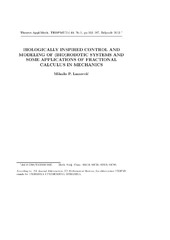Приказ основних података о документу
Biološki inspirisano upravljanje i modeliranje (bi)robotskih sistema i neke primene frakcionog računa u mehanici
Biologically inspired control and modeling of (bio)robotic systems and some applications of fractional calculus in mechanics
| dc.creator | Lazarević, Mihailo | |
| dc.date.accessioned | 2022-09-19T17:05:46Z | |
| dc.date.available | 2022-09-19T17:05:46Z | |
| dc.date.issued | 2013 | |
| dc.identifier.issn | 1450-5584 | |
| dc.identifier.uri | https://machinery.mas.bg.ac.rs/handle/123456789/1619 | |
| dc.description.abstract | U ovom radu, prezentovane su primene biološki inspirisanog modeliranja i upravljanja (bio)mehaničkim (ne)redundantnim mehanizmima, kao i novodobijeni rezultati autora u oblasti primenjene mehanike koji su zasnovani na primeni računa necelobrojnog reda. Prvo, predloženo je korišćenje biološkog analogona-sinergije zahvaljujući postojanju nepromenljivih odlika u izvršavanju funkcionalnih pokreta. Drugo, model (bio)mehaničkog sistema može se dobiti primenom drugog biološkog koncepta poznatim pod nazivom distribuirano pozicioniranje (DP), koji je zasnovan na inercijalnim svojstva i pokretanju zglobova razmatranog mehaničkog sistema. Takođe,predlaže se korišćenje drugih bioloških principa kao što su: princip minimalne interakcije, koji ima glavnu ulogu u hijerarhijskoj strukturi upravljanja i princip samopodešavanja (uvodi lokalne pozitivnu/negativnu povratnu spregu u upravljačkoj petlji i to sa velikim pojačanjem), koji omogućava efikasno ostvarivanje upravljanja na bazi iterativnog prirodnog učenja. Takođe, novi, nedavno publikovani rezultati autora su takođe predstavljeni u oblasti stabilnosti, elektro-viskoelastičnosti i teoriji upravljanja a koji su zasnovani na korišćenju računa necelobrojnog reda. | sr |
| dc.description.abstract | In this paper, the applications of biologically inspired modeling and control of (bio)mechanical (non)redundant mechanisms are presented, as well as newly obtained results of author in mechanics which are based on using fractional calculus. First, it is proposed to use biological analog-synergy due to existence of invariant features in the execution of functional motion. Second, the model of (bio)mechanical system may be obtained using another biological concept called distributed positioning (DP), which is based on the inertial properties and actuation of joints of considered mechanical system. In addition, it is proposed to use other biological principles such as: principle of minimum interaction, which takes a main role in hierarchical structure of control and self-adjusting principle (introduce local positive/negative feedback on control with great amplifying), which allows efficiently realization of control based on iterative natural learning. Also, new, recently obtained results of the author in the fields of stability, electroviscoelasticity, and control theory are presented which are based on using fractional calculus (FC). | en |
| dc.publisher | Srpsko društvo za mehaniku, Beograd | |
| dc.relation | info:eu-repo/grantAgreement/MESTD/Technological Development (TD or TR)/35006/RS// | |
| dc.rights | openAccess | |
| dc.rights.uri | https://creativecommons.org/licenses/by-nc-nd/4.0/ | |
| dc.source | Theoretical and Applied Mechanics | |
| dc.subject | stabilnost | sr |
| dc.subject | frakcioni račun | sr |
| dc.subject | biološki inspirisani sistemi | sr |
| dc.subject | algoritmi upravljanja | sr |
| dc.subject | stability | en |
| dc.subject | modeling | en |
| dc.subject | fractional calculus | en |
| dc.subject | control algorithms | en |
| dc.subject | biologically inspired systems | en |
| dc.title | Biološki inspirisano upravljanje i modeliranje (bi)robotskih sistema i neke primene frakcionog računa u mehanici | sr |
| dc.title | Biologically inspired control and modeling of (bio)robotic systems and some applications of fractional calculus in mechanics | en |
| dc.type | article | |
| dc.rights.license | BY-NC-ND | |
| dc.citation.epage | 187 | |
| dc.citation.issue | 1 | |
| dc.citation.other | 40(1): 163-187 | |
| dc.citation.rank | M24 | |
| dc.citation.spage | 163 | |
| dc.citation.volume | 40 | |
| dc.identifier.fulltext | http://machinery.mas.bg.ac.rs/bitstream/id/472/1616.pdf | |
| dc.identifier.rcub | https://hdl.handle.net/21.15107/rcub_machinery_1619 | |
| dc.type.version | publishedVersion |


